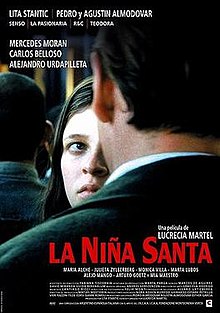The Holy Girl (film)
| The Holy Girl | |
|---|---|

Theatrical release poster
|
|
| Directed by | Lucrecia Martel |
| Produced by | Lita Stantic |
| Written by | Lucrecia Martel |
| Starring |
Mercedes Morán Carlos Belloso Alejandro Urdapilleta María Alche |
| Music by | Andres Gerszenzon |
| Cinematography | Félix Monti |
| Edited by | Santiago Ricci |
|
Production
company |
|
| Distributed by | HBO Films |
|
Release date
|
|
|
Running time
|
106 minutes |
| Country | Argentina Italy Spain Netherlands |
| Language | Spanish |
The Holy Girl (Spanish: La niña santa) is a 2004 Argentinian drama film directed by Lucrecia Martel. The picture was executively produced by Pedro Almodóvar, Agustín Almodóvar, and Esther García. It was produced by Lita Stantic. The film features Mercedes Morán, María Alche, Carlos Belloso, Alejandro Urdapilleta, Julieta Zylberberg, among others.
The film takes place in the small town of La Ciénaga, at the Hotel Termas, a dilapidated Argentine hotel, during a medical conference. Two young teenage girls, Amalia (María Alché) and her best friend Josefina (Julieta Zylberberg), begin to explore their new sexuality and, at the same time, have Catholic religious passion. Amalia lives with her attractive divorced mother (Mercedes Morán), who owns the hotel, and her uncle Freddy (Alejandro Urdapilleta). During this time, in Amalia's mind, spiritual and sexual impulses are seeming to converge.
One day, in the midst of a large crowd watching the performance of a musician playing the theremin, Dr. Jano (Carlos Belloso), a participant in the conference and hotel guest, rubs up sexually against Amalia. She is upset but takes his inappropriate action as a sign that her Catholic faith has given her a mission: to save Dr. Jano from such inappropriate behavior. Afterward, the object of Amalia's desire becomes the married middle-aged doctor and she begins to spy on him. Amalia's story is partly about an adolescent girl's discovery of her sexual vulnerability and the sexual power she possesses.
The screenplay of the film was written by director Lucrecia Martel.
The picture while not exactly autobiographical was based on Martel's memories. Martel said, "The film isn't strictly autobiographical, but what I put in it is my personal experience in life, my memories. When I was in my teens, I was a very religious person. I thought I had a special relationship with God, or anything that was up there. Now, I don't believe in miracles, but I do believe in the emotion you feel in front of a miracle - the emotion of something unexpected revealed to you."
As part of the way she uses the camera the film has few establishing shots or transition shots because she makes the case it physically separates a space from its moment in the film.
Filming location
The film was shot entirely in Salta, in the Salta Province, Argentina. The director/screenwriter was born in Salta.
...
Wikipedia
